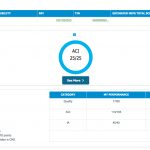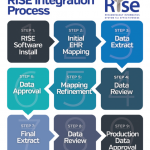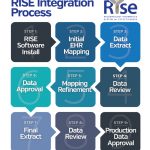As the year begins to wind down, Zach McMurray is gearing up for 2018 MIPS reporting. Despite the “always changing and usually confusing landscape of MACRA/MIPS,” he says his practice isn’t worried because it uses the ACR’s Rheumatology Informatics System for Effectiveness (RISE) qualified clinical data registry.
Mr. McMurray is director of clinical information systems for Rheumatology Associates, a rheumatology practice in Dallas with 19 physicians and a wealth of data. By connecting to RISE, de-identified data pertaining to quality measures from the practice’s electronic health record (EHR) system is linked to the registry. Mr. McMurray is able to assess the data for each physician or the practice through a user dashboard that displays the quality measures available for MIPS reporting, and provides a tallied MIPS score he can track to understand how his practice compares with its own data, and with MIPS benchmarks.
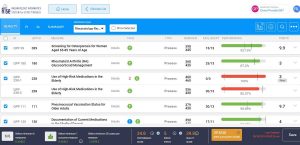
The status of individual measures is easier to view in the new RISE registry dashboard. Click to see full-size image. Image courtesy FIGmd.
“Since the dashboard calculates the scores for you and walks you through the process, it takes the guesswork out of the process,” Mr. McMurray says. He attributes his favorable 2017 MIPS score for reported data to the registry and support from registry staff. “I could not imagine struggling my way through MACRA/MIPS without the RISE dashboard and the team behind it.”
8 Dashboard Improvements
The RISE Registry is made possible through a collaboration between the ACR and FIGmd, a technology company that designs, operates and maintains clinical data registries. Providers who use RISE can work directly with FIGmd practice support specialists and with ACR RISE registry staff members, Janell Martin and Norlita Brown. “Ask questions, and feel confident in your MIPS reporting to earn your best score and payment,” Ms. Martin says.
This team has been working to apply user feedback to optimize the registry dashboard for better usability, functionality and a lighter application to reduce downtime with page loading and dashboard operation, according to FIGmd senior project engineer Dhanraj Gullapalli.
Mr. Gullapalli shares eight RISE dashboard improvements users are now taking advantage of:
- Improved visibility of system status: Users can now see the end view of a submission, including their current estimated MIPS score, as well as any bonus points, all of which updates as new data enter the system.
- Better match between CMS requirements and practice/provider status: This makes it easier for users to navigate the dashboard, with easier-to-read icons, directions and directed actions. For example, there is now a clearer and more direct path to enter a provider’s national provider identification (NPI) number to check if they are exempt from MIPS.
- More standardized, systemwide terminology: This makes it easier for users to efficiently operate within the system to complete needed actions, such as canceling or updating data.
- Advanced error prevention: When manually entering Promoting Interoperability (PI) data, if data entry does not match the CMS database and/or reporting requirements, users will see a red alert message and a warning to correct the mistake. Users cannot save their entries until the error is corrected. Green confirmation messages signify a correct, successful action.
- Improved loading speed: By making system functionality more efficient, users can expect shorter wait times for a page to load once information is added.
- More efficient navigation: Users can now see multiple action options from the main dashboard page, rather than having to move through several pages to reach a desired action.
- Cleaner design: With better use of white space, easier-to-read typography and more logical information groupings, information on each page of the dashboard is easy to read and navigate at a glance.
- More navigation support: A new dashboard tutorial walks users through each key step in dashboard use, and one-on-one support can help individual providers improve their MIPS reporting potential.
Ready for RISE?
Currently, RISE data include more than 9.8 million patient encounters representing more than 1.6 million patients. Ms. Brown says new providers are always welcome to join the registry and receive support in their efforts to meet federal reporting requirements. MIPS-eligible clinicians include physicians (e.g. MD, DO), physician assistants, nurse practitioners, clinical nurse specialists and certified registered nurse anesthetists.
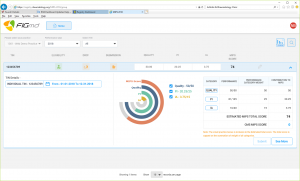
MIPS score status and the breakdown of scoring details are spelled out more clearly in the new RISE registry dashboard. Click to see full-size image. Image courtesy FIGmd.
Ms. Brown says providers are working to meet these federal reporting requirements and RISE helps them do that, but the end goal is truly to improve patient outcomes by understanding performance in key practice measures. “With this new dashboard, providers have a much clearer and easier-to-operate tool for seeing where they can improve patient care.”
Dashboard Demo
Demonstrations of the new RISE Registry dashboard will be possible upon request at the ACR/AHRP Annual Meeting in Chicago, Oct. 19–24. Stop by the RISE registry booth at the Discovery Center in the exhibit hall to sign up for a 30-minute consultation and learn about the opportunities RISE offers for your practice.
Additional Resources
Learn how rheumatologists have incorporated the RISE registry into quality improvement efforts.
Carina Stanton is a freelance science journalist based in Denver.
